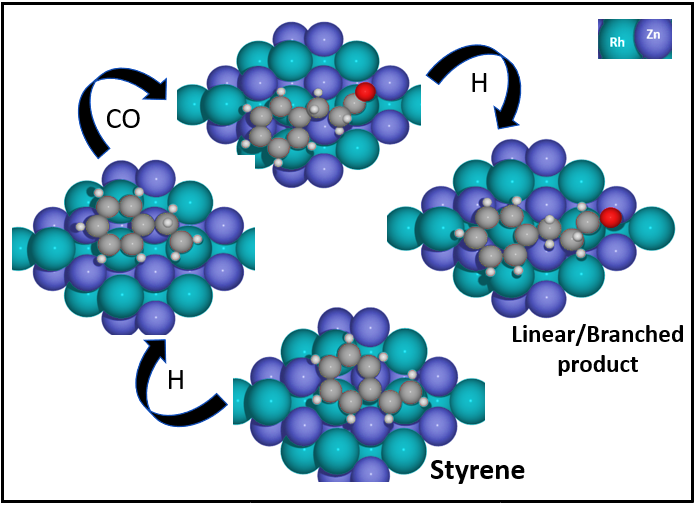Hydroformylation of olefins to aldehydes is a critical chemical technology with over 10 million tons of production annually. Numerous efforts have been made to design catalysts, such Rh-based homogeneous catalysts or single atom catalyst (SACs) supported on MOFs, that yield suitable selectivity and activity.
1,2 However, challenges such as catalyst stability, high metal loading, and poor control over the product linear to branched ratio motivate the continued development of improved catalysts. One interesting prospective class of materials for hydroformylation includes ordered intermetallic, which have been noted for their ability to control catalytic behavior with greatly improved stability.
3
In this presentation, we describe a combined theoretical and experimental approach toward understanding reaction mechanisms of styrene hydroformylation on intermetallic surfaces. We utilize density functional theory (DFT) calculations of hydroformylation thermochemistry and kinetics to elucidate the detailed reactivity of several low-energy RhZn surfaces (ZnRh(100), ZnRh(111), ZnRh(210), ZnRh(110)), toward the overall goal of understanding the nature of the active site for this reaction and the reason for the significantly improved activity relative to pure Rh(111). Our results suggest that alloying Rh with a relatively inactive metal such as Zn weakens the binding of surface intermediates; the reaction landscape is therefore considerably impacted by the relative amounts of Zn and Rh found on the considered surfaces. Theoretical results are considered in the context of experimental studies of styrene hydroformylation on intermetallic RhZn supported on mesoporous SBA-15. These experimental results show our intermetallic RhZn outperforms a benchmark homogeneous catalyst.
References
- Hou, C.; Zhao, G.; Ji, Y.; Niu, Z.; Wang, D.; Li, Y. Nano Research 2014, 7 (9), 1364-1369.
- Wang, L. B. et al., Nature Communications 2016,
- Miyazaki, M., Furukawa, S., Komatsu, T. Am. Chem. Soc. 2017, 139, 18231â18239.


